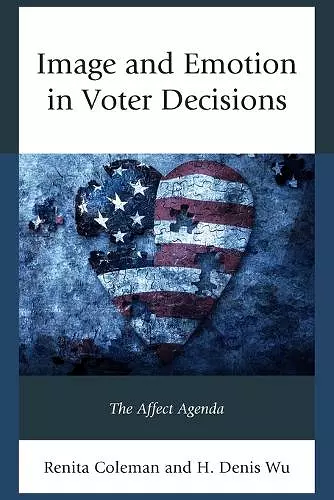Image and Emotion in Voter Decisions
The Affect Agenda
Renita Coleman author Denis Wu author
Format:Paperback
Publisher:Bloomsbury Publishing PLC
Published:30th Aug '16
Currently unavailable, and unfortunately no date known when it will be back

Drawing on a decade of their own research from the 2000 to 2012 U.S. presidential elections, Renita Coleman and Denis Wu explore the image presentation of political candidates and its influence at both aggregate and individual levels. When facing complex political decisions, voters often rely on gut feelings and first impressions but then endeavor to come up with a “rational” reason to justify their actions. Image and Emotion in Voter Decisions: The Affect Agenda examines how and why voters make the decisions they do by examining the influence of the media’s coverage of politicians’ images. Topics include the role of visual and verbal cues in communicating affective information, the influence of demographics on affective agenda setting, whether positive or negative tone is more powerful, and the role of emotion in second-level agenda setting. Image and Emotion in Voter Decisions will challenge readers to think critically about political information processing and a new way of systematically thinking about agenda setting in elections.
From the perspective that elections should involve the rational evaluation of candidates’ issue positions, campaigns and voters that focus on images and emotions are generally disdained. But Coleman and Wu argue that candidate images and voter emotions are central to the electoral process because they stimulate voters to evaluate candidates. Previous research in political communication has focused largely on the first level of agenda setting (addressing issues), but in this book, the authors analyze the second level of agenda setting (addressing affect). This work is unique in two ways. First, it focuses on the visuals of candidates, rather than their words, and assesses them as positive or negative. Second, it measures the positive and negative emotions candidates engender in voters. In doing so, it measures the impact that mediated affect has on elections. The authors use a multi-modal approach that uses experiments as well as surveys that vary across time and location. The result is an overwhelmingly persuasive argument that the candidate images broadcast by various news media play an important role in the public agenda during elections. Summing Up: Highly recommended. Graduate, research, and professional collections. * Choice Reviews *
Image and Emotion in Voter Decisions makes a great contribution in political communication scholarship, specifically the role of visual communication in politics—an area that is clearly understudied. To borrow David Weaver’s words, the volume is an important addition to the agenda-setting and voting literature in many ways. It draws its strength from three key aspects: (a) the strong emphasis on the role of visual content to provide evidence for the second-level agenda-setting effects; (b) the combination of various theories of information processing and media effects models to provide a stronger evidence of the influence of politicians’ images on voters during elections; and (c) use of comprehensive data from four presidential elections in the United States and one in Taiwan—making the volume fact-laden—hence providing useful insights on the topics of inquiry. I would not hesitate to recommend this book to a researcher seeking to gain useful knowledge of literature that documents the power of visual communication in politics. * Journalism & Mass Communication Quarterly *
"The book fills a gap in agenda setting literature, I highly recommend it."? -- Guy J. Golan, Syracuse University
“This is an important addition to the agenda-setting and voting literature in several respects. It brings various theories of information processing to bear on agenda-setting research, and it emphasizes the role of visual content in agenda-setting effects. It also analyzes the relative strength of first- and second-level agenda-setting effects on voting behavior in one Taiwanese and four U.S. presidential elections. As such, this program of work represents probably the only longitudinal effort so far to examine visuals for their second-level agenda setting effects.” -- David H. Weaver, Indiana University
Building on the cognitive approach prevalent in most political communication scholarship, this book provides a comprehensive overview of the role of visual information and emotion in news and its impact on voter decisions. It is a must-read for political communication researchers, educators, and professionals. -- Spiro Kiousis, University of Florida
ISBN: 9781498514033
Dimensions: 231mm x 151mm x 17mm
Weight: 363g
282 pages